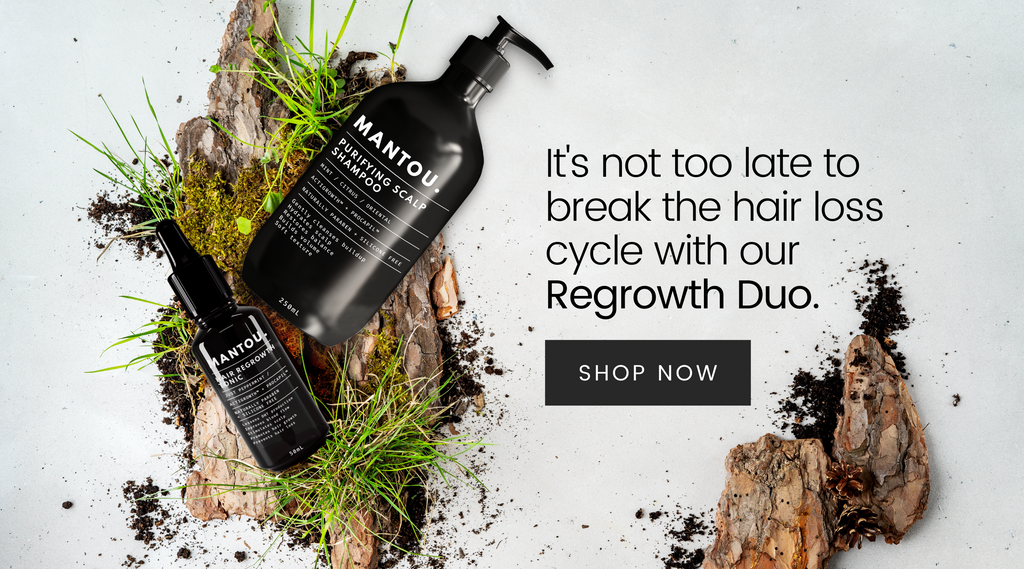Hairloss 101
What causes hair loss?
We typically lose 50 to 100 hairs a day and it's usually not noticeable because new hair grows at the same time. Hair loss occurs when new hair doesn't replace the hair that's dropped. Hair loss is typically a result of 4 common causes:
- Heredity
- Medical conditions
- Hormones
- Scalp care
Heredity (Family History)
One of the most common causes of hair loss is a condition called "androgenic alopecia" A.K.A. a hereditary hair loss condition that happens with aging.
Medical Conditions
Common medical conditions include, alopecia areata and trichotillomania. Alopecia areata is an immune system related condition which causes the body to attack its own hair follicles. Trichotilomania is a mental health disorder where a person compulsively pulls their own hair. Stress, severe illnesses or traumatic events can also cause temporary hair loss - this is called telogen effluvium.
Dihydrotestosterone (DHT)
Science confirms that the exact trigger for male-pattern hair loss is a hormone called dihydrotestosterone (DHT). DHT comes from your natural production of testosterone - men with male-pattern hair loss have inherited a sensitivity to DHT in your hair follicles. DHT causes a miniaturisation of the hair follicle which leads to overall weakening of hair growth. That's what causes receding hairlines and thinning at the crown of your head.
Scalp Care
How we take care of our scalp plays a super important part in preventing hair loss and hair thinning and other scalp issues like dandruff and oily scalp. You need to rethink how you shampoo.

Most men tend to shampoo daily, but over-cleansing has a negative impact on the scalp and can destroy its equilibrium. Cutting back your shampoo routine or using a more gentle cleanser (like MANTOU's Purifying Scalp Shampoo) can clear buildup from product and impurities like dandruff on your scalp without stripping it of essential oils and moisture.
Common Types of Hair Loss

Loss prevention
For guys who have a decent amount of hair, prevention is the best cure - especially if hair loss runs in the family. Treatment may sometimes take time to make an impact, so it's best to get a head start.

Thinning at the crown
Light bald spots may start to develop on top of the scalp - hair at the crown of the head becomes sparser. This is one of the common early signs of male pattern balding.

Receding hairline
Hair thinning tends to start from the hairline to the back of the head - resulting in an M-shaped or horseshoe hairline. This is often caused by a combo of heredity and ageing.

Thinning all over
Sometimes balding may not start at the crown or at the hairline - it may develop and advance at a steady rate along a larger area of your scalp due to closing follicles as we age.
How to Actually Prevent Hair Loss
There are lots of gimmicky devices, expensive procedures and fluffy-miracle treatments out there. In reality, there are really only a few things that actually work.
1. Start treatment as soon as you notice a change in your hair.
Prevention is the best cure. Treating hair loss during an early stage can help save existing hairs on your head and increase the efficacy of a treatment.
2. Build a haircare regime that works for you
We did our research and formulated a two-step hair loss prevention routine for you to consider. They work to stimulate regrowth on inactive and weakened follicles. Using these ingredients in tandem create an even stronger defence against hair loss.
Procapil™: A new-age botanical formula extracted from olive tree leaves that fights the follicle ageing process by giving strength to existing hair follicles and preventing hair loss naturally. Procapil™ targets poor scalp micro-circulation, follicle ageing and growth caused by the male hormone DHT.
Learn more about our key ingredients here.

